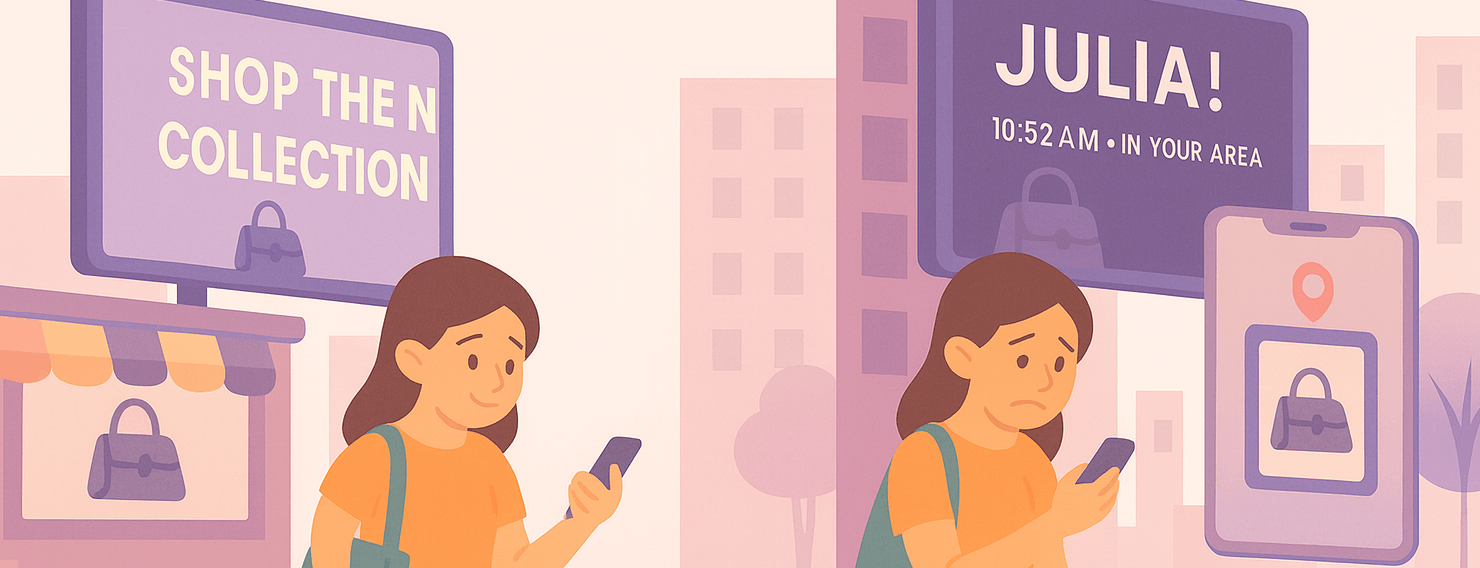Table of Contents
- Key Takeaways
- The Rise of AI Recommendations in Online Shopping
- When Smart Guidance Misses the Mark
- Why Customers Feel Creeped Out
- Red Flags in Your Product Recommendation Engine
- Customer Fatigue: What the Data Says
- Targeting Without Overstepping
- Brands Getting It Right
- Future-Proofing Personalized Recommendations
- Conclusion
Ever feel like your phone is eavesdropping? You mention hiking boots to a friend, and boom, your next scroll is full of trail gear ads. Coincidence? Maybe. But let’s be real: ecommerce recommendations can get real personal, real fast.
Don’t get us wrong, when done right, it’s super helpful. Personalized product picks, smart search results, even reminders for items you actually wanted? Yes, please. But there’s a fine line between helpful and… a little too much.
As online stores lean on AI-powered product recommendation engines to tailor every click, swipe, and scroll, the customer experience becomes more curated than ever. The question is – at what point does that curated journey start to feel invasive?
In this article, we’ll explore when ecommerce product highlights hit the sweet spot and when they start to weird people out. Because keeping things personal shouldn’t mean crossing the line.
Key Takeaways
- Personalized recommendations are powerful, but they need boundaries. When tailored experiences go too far, they stop feeling helpful and start feeling invasive. Striking the right balance builds trust.
- Over-personalization can backfire. Constant retargeting, hyper-specific messages, and poorly timed recommendations lead to customer fatigue, disengagement, and even loss of brand loyalty.
- Context matters more than quantity. It’s not about using more data, but using the right data in the right moment. Context-aware product prompts feel natural, not pushy.
- Transparency builds trust. Privacy-first design, clear opt-ins, and explainable AI are becoming non-negotiable. Customers want to understand why they’re seeing something.
- With growing regulations and rising consumer awareness, brands that embed consent, control, and empathy into their product recommendation engines will stand out.
The Rise of AI Recommendations in Online Shopping
Product recommendations didn’t always mean AI reading your mind. In the early days, it was as simple as: “Hey, you bought a backpack, maybe you want a matching water bottle.” Just basic segmentation based on what others bought.
Then came smarter systems: email triggers, behavioral tracking, and dynamic product displays. Today? It’s a whole new level. We’re talking hyper-personalization, powered by machine learning and real-time data. Your browsing habits, purchase history, even the time of day you shop – it’s all fair game for modern product recommendation engines.
And the numbers don’t lie. According to McKinsey, relevant suggestions can boost revenue by 10-15% and improve marketing ROI by up to 30%. That’s huge. But here’s the flip side: 44% of consumers say creepy or overly aggressive targeting makes them lose trust in a brand.
So yes, data-driven UX has evolved, and it’s powerful. But with great power comes the need for even greater customer sensitivity.
When Smart Guidance Misses the Mark
Tailored recommendations are awesome until they start to feel like surveillance. That’s when you cross into over-personalization territory.
So, what does that look like? It’s when the tone gets too familiar (“Hey Sam, those shoes you looked at yesterday are still waiting”), or the timing is a little too perfect – like an ad showing up for something you barely Googled five minutes ago. Or worse, when a brand keeps pushing the same product after you’ve already bought it. Been there?
These aren’t just awkward moments, they’re trust killers. And when customers get hit with this kind of laser-targeted content over and over, it creates what’s called discovery fatigue. That’s when the experience stops feeling special and starts feeling exhausting. Like, “Can I just browse without being followed for once?”
Bottom line: even with all the right data, sometimes less really is more.
Why Customers Feel Creeped Out
Ever get a product highlightn so spot-on it feels like the site knows you? Not in a “wow, convenient” way, but more like “wait… how do you know that about me?” That’s the uncanny valley of UX, when tech starts acting too human and it stops being cool.
What really tips it over the edge? A lack of transparency. Customers don’t always know how their data is being used. Is it from that wishlist they made? Their last order? Or something creepier, like cross-site tracking or third-party cookies?
There’s a fine line between feeling understood and feeling watched. When a product recommendation engine hits too many personal notes, especially without context, it creates discomfort, not delight.
And once that line is crossed, trust vanishes fast. People start questioning the brand. “What else do they know?” “Who else has my data?” Personalized prompts lose their charm the moment they stops feeling respectful and starts feeling invasive.
Red Flags in Your Product Recommendation Engine
Sometimes your product recommendation engine might be quietly working against you, alienating shoppers instead of engaging them.
Here are a few red flags to watch out for:
- Over-targeting frequent visitors: Just because someone browses often doesn’t mean they want to see the same product five times a day. Overexposure can lead to frustration, or worse, abandonment.
- Irrelevant suggestions caused by overfitting: When your system clings too tightly to one past behavior (like a one-time gift purchase), it might miss the bigger picture. A customer who once bought baby shoes isn’t necessarily in the market for diapers forever.
- Recommendations based on sensitive purchases: Suggesting more grief books after someone buys a sympathy gift? That’s not thoughtful, it’s tone-deaf.
These moments often come from blind spots in your data-driven UX, where the algorithm focuses too narrowly on past clicks without understanding context. That tunnel vision can make even the smartest AI feel disconnected, robotic, or just plain wrong.
Customer Fatigue: What the Data Says
It turns out that even helpful suggestions can wear out their welcome if they’re not timed or targeted well.
A recent Gartner survey found that 53% of customers had “negative experiences” with targeted marketing, making them 44% less likely to buy again and significantly more prone to regret their purchase. What’s more, over half of customers reported feeling overwhelmed or rushed by traditional personalization tactics at least once during their buying journey. That means less time on site, fewer clicks, and declining trust.
Repetitive prompts are among the top offenders. Think about it: if you’ve already ignored a product three times, chances are the fourth time won’t magically spark interest. For many users, it just feels like the brand isn’t listening.
Interestingly, generational attitudes differ. Gen Z and Millennials are generally more open to personalized recommendations if done right. But even they have limits. Boomers, on the other hand, tend to be more skeptical from the start, with privacy concerns ranking much higher.
Bottom line? Over-personalization fatigue is real and rising. The smarter move isn’t always “more data,” but better timing, smarter context, and giving users control.
Targeting Without Overstepping
So how do you keep your product suggestions helpful, not haunting? It all starts with context.
Great recommendations aren’t just about what you show, but when and where you show it. A gentle nudge during a weekend browse session on mobile? Cool. The same message blasted three times during a workday scroll? Not so much. Smart brands factor in timing, platform, and even customer mood, not just purchase history.
That’s where data-driven UX shines: not to stalk users, but to support their journey. Think of it like a helpful in-store associate, not someone who follows you around whispering what you looked at last week.
Even more important? Consent-first design. Let users know what data you’re using. Give them controls to opt in, opt out, or tweak their preferences. Transparency builds trust.
Just compare Spotify Wrapped – a yearly, feel-good surprise based on user data – with Facebook’s infamous eavesdropping rumors. One feels fun and empowering. The other? Kind of creepy.
The difference isn’t just in the data, it’s in the delivery.
Brands Getting It Right
Plenty of brands are proving that you can tailor the shopping experience without being pushy, and customers love them for it.
Take ASOS, for example. Their product recommendation engine doesn’t simply echo what you clicked, it actually learns your style over time. Instead of overwhelming you with “seen it already” picks, it surfaces fresh finds in your size, budget, and vibe. It feels like a stylist, not a stalker.
Then there’s Sephora, which nails it by blending data with subtlety. Their “You Might Also Love” sections feel curated, not aggressive. Even better? They mix in seasonal picks and user-favorite trends, keeping things relevant and timely, not just algorithmic echoes.
Another great one: Etsy. It uses predictive categories and browsing behavior to suggest similar shops or handmade items. It’s discovery-focused, helping users explore more of what they already love without ever feeling invasive.
These brands get it – one must be quietly helpful, guiding the buyer journey without hijacking it.
Future-Proofing Personalized Recommendations
As these tools get more powerful, the spotlight is turning to how they work, not just what they deliver. Consider ethical AI and the push for transparency in recommendation systems.
Customers today aren’t just asking, “Why am I seeing this?”. They expect answers. That’s where AI explainability comes in. When brands can clearly communicate why a product was recommended, it builds trust and shows respect for the user’s experience.
We’re also seeing a shift toward privacy-first design. That means collecting less data, but using it smarter, with full consent, clear settings, and meaningful customization options. Think: zero-party data strategies and preference centers over shadowy tracking.
And the writing’s on the wall: regulations are coming. From GDPR to the evolving US privacy laws, the future favors brands that bake ethics into their marketing strategies from the start. The upside? More transparency = more customer empowerment = deeper loyalty.
Conclusion
In ecommerce, thoughtful product nudges can be a true superpower, but like any power, they need boundaries. When done right, they feel intuitive, effortless, even delightful. When they go too far, they risk turning your best customers into skeptics.
If you’re in charge of crafting those experiences, now’s the time to take a step back. Audit your marketing flows. Look at what you’re recommending, when you’re doing it, and how it might be coming across. Is it helpful? Or is it hovering?
Start with this checklist of 7 Signs You’re Over-Personalizing:
- You’re still recommending a product they already bought.
- The same items follow them across every device and platform.
- Product suggestions ignore context (mood, timing, situation).
- Messaging sounds eerily specific or overly familiar.
- Users can’t easily customize or opt out of recommendations.
- Sensitive purchases trigger awkward follow-ups.
- Customers are bouncing faster, not clicking deeper.
If you checked more than a couple of these, time to recalibrate. Keep it smart, keep it human, and always, always keep it respectful.


































 Christina Sol
Christina Sol 




 Greg Raileanu
Greg Raileanu 